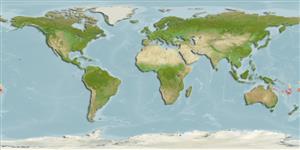Preferred temperature (Ref.
123201): 24.7 - 27.5, mean 26.1 °C (based on 213 cells).
Phylogenetic diversity index (Ref.
82804): PD
50 = 0.5000 [Uniqueness, from 0.5 = low to 2.0 = high].
Bayesian length-weight: a=0.00562 (0.00258 - 0.01228), b=3.06 (2.87 - 3.25), in cm total length, based on LWR estimates for this (Sub)family-body shape (Ref.
93245).
Trophic level (Ref.
69278): 3.4 ±0.4 se; based on size and trophs of closest relatives
Resilience (Ref.
120179): High, minimum population doubling time less than 15 months (Preliminary K or Fecundity.).
Fishing Vulnerability (Ref.
59153): Low vulnerability (10 of 100).
Nutrients (Ref.
124155): Calcium = 469 [172, 1,316] mg/100g; Iron = 1.24 [0.58, 2.81] mg/100g; Protein = 17.2 [15.7, 18.6] %; Omega3 = 0.116 [0.043, 0.305] g/100g; Selenium = 11.9 [3.4, 38.7] μg/100g; VitaminA = 985 [197, 5,244] μg/100g; Zinc = 4.54 [2.40, 7.79] mg/100g (wet weight);
